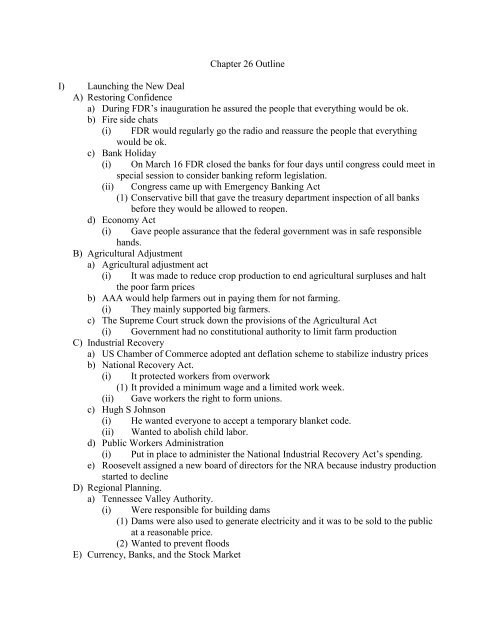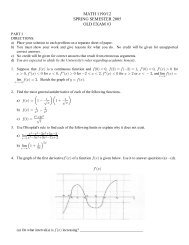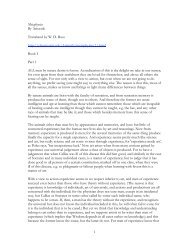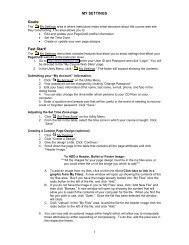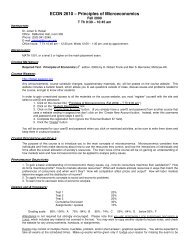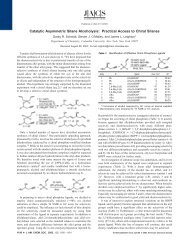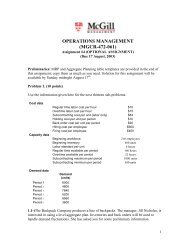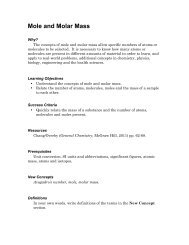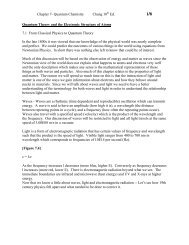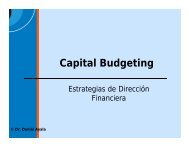Chapter 26 Outline I) Launching the New Deal A ... - PageOut
Chapter 26 Outline I) Launching the New Deal A ... - PageOut
Chapter 26 Outline I) Launching the New Deal A ... - PageOut
Create successful ePaper yourself
Turn your PDF publications into a flip-book with our unique Google optimized e-Paper software.
<strong>Chapter</strong> <strong>26</strong> <strong>Outline</strong>I) <strong>Launching</strong> <strong>the</strong> <strong>New</strong> <strong>Deal</strong>A) Restoring Confidencea) During FDR’s inauguration he assured <strong>the</strong> people that everything would be ok.b) Fire side chats(i) FDR would regularly go <strong>the</strong> radio and reassure <strong>the</strong> people that everythingwould be ok.c) Bank Holiday(i) On March 16 FDR closed <strong>the</strong> banks for four days until congress could meet inspecial session to consider banking reform legislation.(ii) Congress came up with Emergency Banking Act(1) Conservative bill that gave <strong>the</strong> treasury department inspection of all banksbefore <strong>the</strong>y would be allowed to reopen.d) Economy Act(i)Gave people assurance that <strong>the</strong> federal government was in safe responsiblehands.B) Agricultural Adjustmenta) Agricultural adjustment act(i)It was made to reduce crop production to end agricultural surpluses and halt<strong>the</strong> poor farm pricesb) AAA would help farmers out in paying <strong>the</strong>m for not farming.(i) They mainly supported big farmers.c) The Supreme Court struck down <strong>the</strong> provisions of <strong>the</strong> Agricultural Act(i) Government had no constitutional authority to limit farm productionC) Industrial Recoverya) US Chamber of Commerce adopted ant deflation scheme to stabilize industry pricesb) National Recovery Act.(i) It protected workers from overwork(1) It provided a minimum wage and a limited work week.(ii) Gave workers <strong>the</strong> right to form unions.c) Hugh S Johnson(i) He wanted everyone to accept a temporary blanket code.(ii) Wanted to abolish child labor.d) Public Workers Administration(i) Put in place to administer <strong>the</strong> National Industrial Recovery Act’s spending.e) Roosevelt assigned a new board of directors for <strong>the</strong> NRA because industry productionstarted to declineD) Regional Planning.a) Tennessee Valley Authority.(i)Were responsible for building dams(1) Dams were also used to generate electricity and it was to be sold to <strong>the</strong> publicat a reasonable price.(2) Wanted to prevent floodsE) Currency, Banks, and <strong>the</strong> Stock Market
a) On April 18, 1933, Roosevelt made <strong>the</strong> shift off <strong>the</strong> gold standard official wi<strong>the</strong>xecutive order.b) The Glass Steagall Act(i) Gave <strong>the</strong> government <strong>the</strong> authority to curb bad speculation by banksc) Securities and Exchange commission was established to police <strong>the</strong> stock market.II)F) The Growth of Federal Relief.a) Federal Emergency Relief Administration(i) Provided cash grantes to states to prop up bankrupt relief agencies.b) Civeil Works Administration(i) Put almost 4 million people into temporary jobs.c) Civilian Conservation Corps(i) A relief project that helpe unemployed men find jobs by having <strong>the</strong>m work ofbuilding parks and dams.The <strong>New</strong> <strong>Deal</strong> in TransitionA) Critics of <strong>the</strong> <strong>New</strong> <strong>Deal</strong>.a) Townsend Plan(i) A pension plan created by Dr. Francis E. Townsend(1) All Americans 60 and older would receive 200 dollars a month for a pension.(ii) Led to <strong>the</strong> social security planb) Huey Long(i) He was a senator for Louisiana who was against <strong>the</strong> new deal policies(ii) Wanted to use <strong>the</strong> Share our wealth program(1) It would use <strong>the</strong> tax system to confiscate <strong>the</strong> surplus riches of <strong>the</strong> wealthiestmen and women in America and distribute <strong>the</strong>se surpluses to <strong>the</strong> rest of <strong>the</strong>population.B) The Second <strong>New</strong> <strong>Deal</strong>a) Roosevelt began to impose tax reforms.C) Labor Militancya) Workers began to take advantage of section 7(a)(i) Although <strong>the</strong>y did it violently.b) Unions become joined toge<strong>the</strong>r(i) Any company having to do with steel was in a steel union.D) Organizing Battlesa) Sit down strikes(i) The United Auto Workers union was <strong>the</strong> first to use this method.(ii) This enabled <strong>the</strong> company to use strike breakers.b) Every union was fighting to be recongnized by <strong>the</strong> big companies.c) By <strong>the</strong> end to 1937 8 million people were involved in unions.E) Social Securitya) Socially Security Act(i)(ii)It gave retired people moneyGave a system of unemployment insurance(1) People who did not work would get money from <strong>the</strong> governent for a limitedtimeF) <strong>New</strong> Directions in Relief
a) In 1935 Roosevelt established <strong>the</strong> Works Progress Administration(i) It help create jobs for unemployed Americans.b) Many o<strong>the</strong>r agencies began to be established to help o<strong>the</strong>r unemployed people withdiffenent skills.G) The 1936 Referenduma) Roosevelt ran again for office and won overwhelmingly.III) The <strong>New</strong> <strong>Deal</strong> in DisarrayA) The Court Fighta) In 1936 FDR wanted to replace <strong>the</strong> six justices and put in six new liberal ones.B) Retrenchment and Recessiona) The recession was blamed on Roosevelt’s decision to ask <strong>the</strong> people to cut back onpublic spendingb) Fair Labor Standards Act(i) It established a minimum wage and a 40 hour work week.IV) Limits and Legacies of <strong>the</strong> <strong>New</strong> <strong>Deal</strong>.A) The Idea of <strong>the</strong> Broker State.a) It was <strong>New</strong> <strong>Deal</strong> liberals that established <strong>the</strong> Broker State(i) Instead of forging all elements of society into a single harmonious unit assome reformers had once hoped to do <strong>the</strong> real achievement of <strong>the</strong> <strong>New</strong> <strong>Deal</strong> wasto elevate and streng<strong>the</strong>n new interest groups so as to allow <strong>the</strong>m to compete moreeffectively in <strong>the</strong> national marketplace.b) Later <strong>the</strong> Broker State was expanded to embrace o<strong>the</strong>r groupsB) African Americans and <strong>the</strong> <strong>New</strong> <strong>Deal</strong>a) The <strong>New</strong> <strong>Deal</strong> did little to help blacks but it was kinder to <strong>the</strong>m.b) The Black Cabinet(i)FDR had place some black people in certain political positions and got <strong>the</strong>nick name Black cabinet.c) FDR would not make poll taxes illegal or support Lynching as a federal crime.d) Although many of <strong>the</strong> government reform programs accepted blacks, <strong>the</strong>y did nottreat <strong>the</strong>m <strong>the</strong> same.C) The <strong>New</strong> <strong>Deal</strong> and <strong>the</strong> Indian Problema) John Collier(i)He was a social worker who became committed to Indians after someexposure to tribes in <strong>New</strong> Mexico.b) Indian Reorganization Act(i) Supported by John Collier(ii) It was an act that protected Indian culturalD) Women and <strong>the</strong> <strong>New</strong> <strong>Deal</strong>.a) Secretary of Labor Frances Perkins was <strong>the</strong> first woman appointed to a cabinetposition(i)She did not support equal sex rights because she was scared that that wouldthreaten <strong>the</strong> protective mechanisms that she had helped to established.b) FDR also appointed several o<strong>the</strong>r women to o<strong>the</strong>r key political positionsc) NRA practiced sexually discriminatory wage practicesE) The <strong>New</strong> <strong>Deal</strong> in <strong>the</strong> West and <strong>the</strong> South.a) Some state political leaders did not support <strong>the</strong> new deal
(i)In Colorado <strong>the</strong> leader did not support it and <strong>the</strong> people rioted and looted foodstores.b) Building dams and power sources was <strong>the</strong> most abundant job.c) Rural areas generally did not have electricity until <strong>the</strong> REA provided power lines.d) Americans believed that <strong>the</strong> South was backwardF) The <strong>New</strong> <strong>Deal</strong> and <strong>the</strong> National Economya) The <strong>New</strong> <strong>Deal</strong> did not really impact <strong>the</strong> economyb) It helped <strong>the</strong> small man challenge <strong>the</strong> large companiesc) Welfare was created through social security and o<strong>the</strong>r relief programsG) The <strong>New</strong> <strong>Deal</strong> and <strong>the</strong> American Politicsa) FDR established <strong>the</strong> presidency as a preeminent center of authorityb) The government had new expectations(i) People expected <strong>the</strong> government to take care of <strong>the</strong>m and protect <strong>the</strong>m
<strong>Chapter</strong> <strong>26</strong> SummaryAmerica had been suffering through <strong>the</strong> Great Depression since 1929; President FranklinD. Roosevelt launched <strong>the</strong> <strong>New</strong> <strong>Deal</strong> to get America out of <strong>the</strong> Depression. The first thing he hadto do was restore <strong>the</strong> people’s confidence in <strong>the</strong> nation’s government. His personality helped <strong>the</strong>people believe that he had <strong>the</strong> answer to <strong>the</strong> Depression, and even though he did not know <strong>the</strong>answer himself. After his inauguration he started his plan, he closed all of <strong>the</strong> nation’s banks forfour days a “Bank Holiday”. This was in order to allow Congress could meet in special session toconsider banking-reform legislation. Three days later he sent <strong>the</strong> Emergency Banking Act, whichallowed big banks not to be dragged down by smaller ones. This act restored <strong>the</strong> nation’sconfidence in <strong>the</strong> banking system, this put an end to <strong>the</strong> immediate banking crisis. Alsofollowing his inauguration he repealed prohibition, which took effect in 1933. To solve <strong>the</strong>agricultural problems of <strong>the</strong> period Roosevelt established <strong>the</strong> Agricultural AdjustmentAdministration. The AAA told farmers how much farmers should produce, and how much of<strong>the</strong>ir land should remain idle. This also brought a rise in prices in farming goods, which created arise in farmer’s income after 1933. In order to conserve soil <strong>the</strong> government instituted <strong>the</strong> SoilConservation and Domestic Allotment Act, which <strong>the</strong>y paid farmers to reduce production. Nextwas to fix <strong>the</strong> industrial crisis by forming <strong>the</strong> National Recovery Administration that wascontrolled by Hugh S. Johnson. This administration forced businesses to adhere to <strong>the</strong> new lawsincluding <strong>the</strong> abolition of child labor, fixed wages, and length of workdays. He assuredbusinesses that this would raise consumer purchase power and employment.The NRA guaranteed workers <strong>the</strong> rights to form and join unions. The NRA failed tocreate what it was designed to and in 1935 was shut down by <strong>the</strong> Supreme Court. Regionalplanning set up <strong>the</strong> Tennessee Valley Authority to help public development in America. Thisassociation was designed to provide <strong>the</strong> nation with cheap electricity by building a great damscreating hydroelectric power. The <strong>New</strong> <strong>Deal</strong> allowed Roosevelt to change <strong>the</strong> banking system byallowing <strong>the</strong> nations currency to be based on <strong>the</strong> belief in <strong>the</strong> countries government andeconomy. The Glass-Steagall Act allowed government to have authority over banks speculationand monitor it. Now <strong>the</strong> banks were controlled by <strong>the</strong> Federal Reserve Board in WashingtonD.C. instead of all <strong>the</strong> regional banks having control. Under <strong>the</strong> <strong>New</strong> <strong>Deal</strong> <strong>the</strong> stock marketwould now be monitored by <strong>the</strong> Security and Exchange Commission (June 1934) to make sure<strong>the</strong>re would not be ano<strong>the</strong>r crash in <strong>the</strong> future. To curb <strong>the</strong> unemployment Roosevelt created <strong>the</strong>Federal Emergency Relief Commission to help <strong>the</strong> nation.When it was realized that this was not enough he created <strong>the</strong> Civil Works Associationthat put more than four million back to work in less than a year. Ano<strong>the</strong>r source of work createdwas <strong>the</strong> Civilian Conservation Corps in order to put <strong>the</strong> young men of America to work. Thisprogram was set up to create national parks, planting trees, developing parks, irrigation, andbuilding reservoirs. To allow people to get back on <strong>the</strong>ir feet <strong>the</strong> government allowed farmers toget back on <strong>the</strong>ir land to farm, and allowed people to refinance on <strong>the</strong>ir mortgages. Howeversuccessful <strong>the</strong> <strong>New</strong> <strong>Deal</strong> was <strong>the</strong>re were critics that did not agree with Roosevelt’s plan.Opponents of Roosevelt formed <strong>the</strong> American Liberty League to arouse public opposition to <strong>the</strong><strong>New</strong> <strong>Deal</strong>. This group was never able to gain <strong>the</strong> support it needed o<strong>the</strong>r than nor<strong>the</strong>rnindustrialists. O<strong>the</strong>r opponent to <strong>the</strong> <strong>New</strong> <strong>Deal</strong> was Dr. Francis Townsend who with five millionsfollowers created <strong>the</strong> Townsend Plan. This plan was for <strong>the</strong> elderly to able to receive $200 amonth from <strong>the</strong> government if <strong>the</strong>y remained retired, so jobs would free up for <strong>the</strong> youth ofAmerica. The plan made little success in Congress, but was <strong>the</strong> basis for <strong>the</strong> Social Security
system established later in 1935. Social Security was based as insurance not welfare in order forpeople to help have money when <strong>the</strong>y retire. Ano<strong>the</strong>r popular opponent to Roosevelt was SenatorHuey Long of Louisiana who criticized <strong>the</strong> <strong>New</strong> <strong>Deal</strong>. His plan was called <strong>the</strong> Share-Our-WealthPlan which late turned into his own society. The plan called for <strong>the</strong> government to tax <strong>the</strong> richestpeople in America and re-distribute <strong>the</strong> wealth to <strong>the</strong> people. An annual “homestead” of $2,500would be paid after <strong>the</strong> lump sum of $5,000 to <strong>the</strong> people of America. In response to all <strong>the</strong>critics Roosevelt launched <strong>the</strong> so-called “Second <strong>New</strong> <strong>Deal</strong>” in 1935. This deal would shiftpublic attention from critics and o<strong>the</strong>r parties and re-reform <strong>the</strong> continuing economic crisis. Toget <strong>the</strong> publics attention from Long’s plan, Roosevelt instituted a “soak-<strong>the</strong>-rich” plan, in which<strong>the</strong> wealthiest would be taxed to be given to <strong>the</strong> public. This was <strong>the</strong> highest peacetime tax inAmerican history although its impact was limited. Ano<strong>the</strong>r program was set up to fix <strong>the</strong> NIRAand Section 7A passed under <strong>the</strong> <strong>New</strong> <strong>Deal</strong>. The new plan was <strong>the</strong> Wagner Act, which wasdesigned for a board, <strong>the</strong> National Industrial Relations Board, to reorganize unions, and compelworkers to get with legitimate unions. Labor militancy grew during this period and unskilledworkers wanted all <strong>the</strong> workers to be in one union despite <strong>the</strong>ir skills, this was called IndustrialUnionism. Ano<strong>the</strong>r union was formed call <strong>the</strong> Congress of Industrial Organization under <strong>the</strong>irpresident John L. Lewis. The United Auto Workers perfected a new concept <strong>the</strong> sit-down strikewhere workers would sit down and refuse to work or leave. This proved very effective becauseeventually management broke and gave in to <strong>the</strong>ir demands. Labor unions were growing and onMemorial Day in 1937 a group of strikers where marching (legally) and were opened fire uponby police killing ten strikers. In 1935 <strong>the</strong> Works Progress Administration was formed to continueto help people to find work (2.1 million). People would build roads, schools, bridges, airports,and government buildings this also pumped money into <strong>the</strong> economy. In 1936 Roosevelt was reelectedand won easily over Republican candidate Alf Landon of Kansas. After Roosevelt’sreelection he wanted to pack <strong>the</strong> government courts with more liberal view on America. Thescheme failed to work included appointing six new justices to <strong>the</strong> “overworked” court system.In <strong>the</strong> year of 1937 was known as <strong>the</strong> Roosevelt Recession due to <strong>the</strong> reduced amount ofspending <strong>the</strong> government did. Despite trying to fix this by <strong>the</strong> end of 1938 Roosevelt’s <strong>New</strong> <strong>Deal</strong>had ended bringing America out of <strong>the</strong> Depression. The <strong>New</strong> <strong>Deal</strong> did little to assist African-Americans during this time period. Although <strong>the</strong> president himself appointed a “black cabinet”which members made sure that blacks were not excluded from <strong>the</strong> <strong>New</strong> <strong>Deal</strong> programs. Blackssupported Roosevelt because <strong>the</strong>y knew he was not <strong>the</strong>ir enemy but he did little to help <strong>the</strong>m andend discrimination. John Collier was appointed to fix <strong>the</strong> “Indian Problem” and in 1936 heproposed <strong>the</strong> Indian Reorganization Act, which allowed <strong>the</strong>m to own <strong>the</strong>ir own land. Women and<strong>the</strong> <strong>New</strong> <strong>Deal</strong> gained symbolic gains in positions in government. However <strong>the</strong> <strong>New</strong> <strong>Deal</strong> gavelittle opportunities for women to gain success or to receive jobs. The <strong>New</strong> <strong>Deal</strong> in <strong>the</strong> West andSouth helped <strong>the</strong>m greatly, by giving <strong>the</strong>m more funds than o<strong>the</strong>r regions. The <strong>New</strong> <strong>Deal</strong> failedto achieve national recovery in <strong>the</strong> American economy. Ultimately <strong>the</strong> <strong>New</strong> <strong>Deal</strong> gained greatsuccess in Social Security and Federal Relief programs for <strong>the</strong> future. With <strong>the</strong> <strong>New</strong> <strong>Deal</strong>Roosevelt gave new expectations of <strong>the</strong> government to provide assistance to <strong>the</strong> Americanpeople.
<strong>Chapter</strong> <strong>26</strong> TableDiplomatic Economic Cultural• National Labor• “Bank Holiday” • Huey LongRelations Board • Agricultural• Share-Our-Wealth• Sit-down strikeAdjustmentSociety• 1936 “Referendum” Administration• Memorial Day• Establishment of <strong>the</strong> • National RecoveryMassacre“Broker State”System• Organized Labor’s• Public WorksRapid Growth• Second <strong>New</strong> <strong>Deal</strong> • Alf Landon• Works ProgressAdministration• Golden Age of ComicBooks (Heck yes!)(WPA)• End of <strong>the</strong> <strong>New</strong> <strong>Deal</strong>• Roosevelt Recession • Marian Anderson sang• Temporary NationalEconomic Committeeon <strong>the</strong> steps of LincolnMemorial• Fair Labor Standards • “Indian Problem”Act• Symbolic Gains forwomen• Prevailing GenderNorms Buttressed• Failure to challengeJim Crow• Federal WelfareestablishedPolitical• Franklin Roosevelt is inaugurated• The <strong>New</strong> <strong>Deal</strong>• Repeal of <strong>the</strong> 18 th AmendementSocial• Roosevelt’s “fire side chats”• Securities and ExchangeCommission
• Indian Reoganization Act• Glass-Steagall Act• Supreme Court invalidates NRA• Second <strong>New</strong> <strong>Deal</strong>• Supreme Court invalidatesAgricultural Adjustment Act• Sit down strikes• Electoral Realignment• Black Cabinet• Civil Works Administration (CWA)• Civilian Conservation Corps (CCC)• American Liberty League• Townsend Plan• Industrial Unionism• Congress of IndustrialOrganizations (CIO)• Sit-down strikes• Huey Long is assassinated• Unemployment insurance• Court Packing<strong>Chapter</strong> <strong>26</strong> TermsAmerican Liberty league: It was a group formed to gain public opposition to <strong>the</strong> <strong>New</strong> <strong>Deal</strong>’s “dictatorial”policies and its supposed attacks on free enterprise. It was mostly comprised of conservative democratsand corporate leaders claiming <strong>the</strong>re was too much regulation, taxation, and government spending.Popular Front: This method helped to enhance <strong>the</strong> reputation and influence of <strong>the</strong> Communist party aswell as creating political coalitions of all antifascist groups. The groups that were bonded toge<strong>the</strong>r were <strong>the</strong>Communist, Socialist, and Radical parties.Dr. Francis E. Townsend: An elderly physician rose to popularity with his federal pension for <strong>the</strong> elderly.According to his plan, all Americans, 60 and older, would get $200 monthly governmental pensions only if<strong>the</strong>y retired and spent all <strong>the</strong> money each month.Social Security System: It provided coverage for elderly, poverty stricken, and especially those who wereworking who could <strong>the</strong>n place money in <strong>the</strong> system while <strong>the</strong>y worked. Fur<strong>the</strong>rmore, it created a pensionsystem for unemployed Americans.Fa<strong>the</strong>r Charles E. Coughlin: Coughlin, a Catholic priest, was widely known for his nationally broadcastsermons over <strong>the</strong> radio in which he promoted his views as a fascist sympathizer. In addition, he alsosupported a change in <strong>the</strong> banking currency, such as remonetization of silver, distributing greenbacks, aswell as making <strong>the</strong> bank nationalized.
Senator Huey P. Long: He did not support utilities, banks, oil companies and was widely known for hispublic opposition of some of <strong>the</strong>se trades. He even came to end some of <strong>the</strong> opponents’ careers. Althoughsome called him a dictator, he was well liked in Louisiana for his progress, building schools, roads, andhospitals, and was easily elected into <strong>the</strong> Senate.Holding Company Act: An act proposed by Roosevelt, designed to break up <strong>the</strong> great utility holdingcompanies. He spoke harshly of monopolistic control of <strong>the</strong>ir industry. The act, although against manyfurious utilities, limited its effect in <strong>the</strong> economy greatly.Soak <strong>the</strong> Rich Scheme: A series of tax reforms proposed by <strong>the</strong> president in 1935 that conservativescalled <strong>the</strong> “soak <strong>the</strong> rich” scheme. It was basically designed to establish <strong>the</strong> highest and most progressivepeacetime tax rates in history while <strong>the</strong> actual impact was limited.National Labor Relations Act: Also known as <strong>the</strong> Wagner act, gave workers an enforcement mechanismmissing from <strong>the</strong> law, a board known as <strong>the</strong> National Labor Relations Board that could get employers tounderstand and bargain with legitimate unions.Industrial unionism: This approach was supposed to place workers into a single union no matterwhat job or function <strong>the</strong>se workers performed. This method would help workers to increase <strong>the</strong>irpower.John L. Lewis: Lewis, an industrial unionism supporter, attempted to unite <strong>the</strong> AFL and <strong>the</strong> United WineWorkers Association. However, <strong>the</strong>se two groups did not get along. Therefore, he created <strong>the</strong> Committeeon Industrial Organization, but it was later expelled by <strong>the</strong> AFL, and Lewis renamed <strong>the</strong> committee <strong>the</strong>Congress Industrial Organizations. The CIO was established in 1936 and was organized to directly rival<strong>the</strong> AFL with Lewis as its first president.Congress of Industrial Organizations: The CIO was more welcoming to women and blacks and o<strong>the</strong>rminorities, unlike <strong>the</strong> AFL. This group organized drives and targeted previously unorganized industrieswhere women and minorities would be <strong>the</strong> majority of <strong>the</strong> workforce. By 1936, <strong>the</strong> group had already beenassociated with major battles in <strong>the</strong> automobile and steel industries.Sit-Down Strike: A new type of strike workers developed in which <strong>the</strong>y would sit down on <strong>the</strong> job,preventing <strong>the</strong> company from using strikebreakers. This tactic spread to more locations and finallyconsumed 17 General Motors plants. Ignoring court orders and local police efforts to force <strong>the</strong>m out,strikers were finally given a reward by <strong>the</strong> General Motors Company when <strong>the</strong>y became <strong>the</strong> first majormanufacturer to recognize <strong>the</strong> UAW, United Auto Workers union.“Memorial Day Massacre”: A group of strikers formed a picnic and demonstration with <strong>the</strong>ir families andfriends in South Chicago. However, when <strong>the</strong>y attempted to march peacefully, ten demonstrators werekilled and 90 wounded when police opened fire on <strong>the</strong>m. This strike failed, but it was just one of a few thatdid.Social Security Act:: This act was passed in 1935 and provided coverage for elderly, poverty stricken,and especially those who were working who could <strong>the</strong>n place money in <strong>the</strong> system while <strong>the</strong>y worked.Fur<strong>the</strong>rmore, it created a pension system for unemployed Americans.
“Insurance not Welfare”: Insurance not welfare was a system that <strong>the</strong> creators of <strong>the</strong> Social Security Actwanted to create. These programs were similar to insurance programs because <strong>the</strong>y had contributionsfrom participants and benefits available to everyone.Works Progress Administration: The Works Progress Administration was similar to o<strong>the</strong>r civil worksadministrations in <strong>the</strong> fact that it developed a system of work relief for <strong>the</strong> unemployed. This program wasdesigned to fulfill long range goals.Federal Writers Project: This program was a group within <strong>the</strong> Works Progress Administration anddesigned to give unemployed writers a chance to do <strong>the</strong>ir work and receive a government salary.National Youth Administration: A program under <strong>the</strong> Workers Progress Administration that wasdesigned to give work and scholarship assistance to high school and college-aged men and women.National Referendum: A time in history when <strong>the</strong> Democrats won by a large percentage and <strong>the</strong>Democrats increased <strong>the</strong>ir already large majorities in both houses of Congress.Union Party: A group in <strong>the</strong> 1936 Presidential election that received fewer than 900,000 votes. The partywas led by Fa<strong>the</strong>r Charles E. Coughlin and Dr. Francis E. Townsend after <strong>the</strong> assassination of Huey Long.William Lemke was <strong>the</strong> presidential nominee and Thomas C. O’Brien was <strong>the</strong> vice president nominee.Party Realignment: A time when <strong>the</strong> party of <strong>the</strong> Democrats controlled a large group of <strong>the</strong> electorateconsisting of sou<strong>the</strong>rn and western farmers who were poverty stricken and unemployed, <strong>the</strong> urban workingclass and <strong>the</strong> black communities of nor<strong>the</strong>rn cities, in addition to <strong>the</strong> traditional progressives and newliberals. This realignment would force <strong>the</strong> Republican Party out of control of Congress for many years.Coalition: A group that constituted a substantial majority of <strong>the</strong> electorate. For example, <strong>the</strong> Democrats in<strong>the</strong> 1936 election had support from western and sou<strong>the</strong>rn farmers, urban working class, poor andunemployed, nor<strong>the</strong>rn blacks and traditional progressives and committed new liberals.“Court Packing Plan”: A plan in which Roosevelt attempted to appoint six new justices to <strong>the</strong> SupremeCourt, claiming <strong>the</strong> courts were overworked. However, his real purpose was to give himself a chance toappoint new liberal justices and change <strong>the</strong> ideological balance of <strong>the</strong> court.This plan outraged many people, including Roosevelt supporters.Temporary National Economic Committee: The administration created because of Roosevelt’sdisapproval of monopolies and <strong>the</strong>ir power, was also encouraged by younger antimonopolist liberals. Thegroup had members from both houses of Congress and officials from several executive agencies. It spurpose was to examine <strong>the</strong> concentration of monopolies with an eye to major reforms in <strong>the</strong> antitrust laws.Fair Labor Standards Act: The act, <strong>the</strong> first of its kind, established a national minimum wage which was20 cents an hour and a 40-hour work week, also placing strict limits on child labor.
“Broker State”: The real achievement of The <strong>New</strong> <strong>Deal</strong> was to elevate and streng<strong>the</strong>n new groups andallow <strong>the</strong>m to compete. However, reformers had once hoped to forge all elements of society into a singleunit.Marian Anderson: A Black female singer who was not allowed to give a concert in <strong>the</strong> auditorium of <strong>the</strong>Daughters of <strong>the</strong> American Revolution. However, Eleanor Roosevelt resigned from <strong>the</strong> organization and<strong>the</strong>n secured government permission for Marian Anderson to sing on <strong>the</strong> steps of <strong>the</strong> Lincoln Memorial.“Black Cabinet”: A group of second level position black workers appointed by Roosevelt who frequentlyconsulted with one ano<strong>the</strong>r. Robert Weaver, William Hastie, and Mary McLeod Bethue were members of<strong>the</strong> cabinet.John Collier: A former social worker who became committed to <strong>the</strong> causes of Indians after exposure totribal cultures in <strong>the</strong> 1920s. He also believed in <strong>the</strong> idea of cultural relativism, an idea in which each cultureshould be respected on its own terms and no culture was better than ano<strong>the</strong>r.Cultural Relativism: Cultural relativism is an idea in which each culture should be respected on its ownterms and no culture was better than ano<strong>the</strong>r. This concept came into play with <strong>the</strong> Indians because manyAmericans had thought of <strong>the</strong>m as savages for hundreds of years.Indian Reorganization Act: The act restored to <strong>the</strong> tribes <strong>the</strong> right to own land collectively. It increasedtribal land by nearly 4 million acres, as well as agricultural income. The act was also supposed to help <strong>the</strong>Native Americans to regain <strong>the</strong>ir own tribal self government.Frances Perkins: The first female cabinet member in national history was Frances Perkins, Secretary ofLabor, appointed by Roosevelt. She influenced many developments that occurred during <strong>the</strong> time such as<strong>the</strong> Fair Labor Standards act, Civilian Conservation Corps, and <strong>the</strong> National Labor relations act.Hattie Caraway: The first woman ever elected to a full term in <strong>the</strong> U.S. Senate. Hattie Caraway wasappointed in 1934 as a Senator from Arkansas. She was a supporter of FDR’s <strong>New</strong> <strong>Deal</strong> as well as HueyLong’s Share our Wealth campaign.Grand Coulee Dam: Built on <strong>the</strong> Columbia River, this was <strong>the</strong> largest public works project in Americanhistory to that point. It provided cheap electric power for much of <strong>the</strong> northwest, in addition to creating abasis for economic development in <strong>the</strong> region.Bank Holiday: When FDR came into office he shut down all <strong>the</strong> banks for four days <strong>the</strong>n reopened <strong>the</strong>mwith a new bill in place to protect <strong>the</strong> people’s money. During <strong>the</strong> time <strong>the</strong> banks were closed <strong>the</strong>y called it<strong>the</strong> Bank Holiday.Emergency Banking Act: It was a bill that FDR sent to congress that was designed to protect <strong>the</strong> largerbanks from being dragged down by <strong>the</strong> weakness of smaller ones. FDR got <strong>the</strong> idea from Hoover.Radio President: FDR was considered <strong>the</strong> Radio President because he had a perfect radio voice thatallowed him to inspire and make <strong>the</strong> people believe in what it was he was saying.
Agricultural Adjustment Act: This act let <strong>the</strong> farmers basically get paid by <strong>the</strong> government for only doinghalf <strong>the</strong> work. The producers would decide how much <strong>the</strong> production of <strong>the</strong>ir crops should be. Then <strong>the</strong> billwould take affect and tell <strong>the</strong> individual farmer how much to grow and <strong>the</strong>n <strong>the</strong> government would still pay<strong>the</strong> farmers for any cut backs <strong>the</strong>y had to do.National Industrial Recovery Act: This act was important because it gave <strong>the</strong> right for workers to fromunions. It also set up a minimum wage and hours; clerical workers received forty hours a week whileindustrial workers received only thirty six. In addition to setting up minimum hours a week, <strong>the</strong> wage wasplaced at forty cents and hour.Public Works Administration: A group developed after <strong>the</strong> National Industrial Recovery Act to stabilizeand promote purchasing power. It was to administer <strong>the</strong> construction of various projects like dams, bridges,and housing developments.Schechter Decision: The Schechter bro<strong>the</strong>rs opposed a poultry business. The Court ruled unanimouslythat <strong>the</strong> Schechters were not engaged in interstate commerce and fur<strong>the</strong>r that congress did not have <strong>the</strong>right to let <strong>the</strong> president write up <strong>the</strong> draft.Tennessee Valley Authority: A munitions factory set up by Roosevelt with <strong>the</strong> urging of George Norris.The factory quickly became a chemical plant which manufactured fertilizers as well as <strong>the</strong> hydro- electricplant. The dams under <strong>the</strong>ir control helped prevent floods as well as produce cheap electrical power.Glass-Steagall Ac: Acts such as this one helped <strong>the</strong> government authority over previously unregulated orpoorly regulated areas of <strong>the</strong> economy. It gave <strong>the</strong> government <strong>the</strong> authority to curb irresponsiblespeculation by banks. This led to <strong>the</strong> creation of <strong>the</strong> Federal Deposit Insurance which granted all bankdeposits up to $2,500.Truth in Securities Act: The purpose of this act was to protect stock market investors. It requiredcorporations issuing new securities to proved full and accurate information about <strong>the</strong>m to <strong>the</strong> public.Federal Emergency Relief Administration: One of FDR’s first acts as president, <strong>the</strong> FERA provided cashgrants to states to prop up bankrupt relief agencies. FDR choose Henry Hopkins, who gave out <strong>the</strong> grantsquickly and far.Civilian Conservation Corps: The program’s purpose was to find jobs for young men ages 18 to 25.There were camps for this purpose set up all over <strong>the</strong> United States. Some of <strong>the</strong> jobs <strong>the</strong>se menpreformed were planting trees, building parks, draining of swamps, stocking rivers with fish, and working onflood projects.Federal Housing Administration: It was put in place to insure that mortgages for new construction andhome repair.Second <strong>New</strong> <strong>Deal</strong>: FDR was unafraid of going after big companies and tearing <strong>the</strong>m down. He alsoproposed several tax reforms, which help <strong>the</strong> economy, get better. The second new deal was specifically tohelp <strong>the</strong> middle man out of <strong>the</strong> crisis.
Doro<strong>the</strong>a Lange: Lange was a photographer of <strong>the</strong> Depression and throughout <strong>the</strong> recovery period.Photographers like Lange helped to give o<strong>the</strong>rs an insight to what problems people were experiencing ino<strong>the</strong>r parts of <strong>the</strong> country. Her famous photo, Migrant Mo<strong>the</strong>r, touches <strong>the</strong> heart of any person because ofits realness.National Recovery Administration: Roosevelt appointed General Hugh S. Johnson to administer <strong>the</strong>NRA. His job consisted of organizing thousands of businesses with fair trade codes made by tradeassociations and industries.<strong>Chapter</strong> <strong>26</strong> EssaysQ1Thesis: The <strong>New</strong> <strong>Deal</strong> was ineffective in many ways, but it was also effective in o<strong>the</strong>r way that itdealt with <strong>the</strong> Great DepressionA. Didn’t End <strong>the</strong> Great Depressiona. By end of 1939,basic problems of Depression remained unsolvedI. The <strong>New</strong> <strong>Deal</strong> just Held to solve smaller problemsb. Left 15% of work force still unemployedI. Better than <strong>the</strong> 25% beforeii. Everyone needed a jobiii. Men had to leave <strong>the</strong>ir familiesc. Gross national product was no larger than 10 years beforeI. The U.S. was not making any progressii. did not solve <strong>the</strong> problemB. Some achievementsa. created many new broad outlines of politicsI. Everyone got a sayb. constructed foundations for federal welfare systemI. People worked on damsii. People worked on road constructionc. extended national regulation over new areas of <strong>the</strong> economyI. With more jobs’ economy grow
d. presided over <strong>the</strong> birth of <strong>the</strong> modern labor movementI. Now everyone wanted a jobii. There was a lot more jobse. made government a modern major force in <strong>the</strong> agricultural economyI. They stabilized <strong>the</strong> marketii. Bought all of <strong>the</strong> extra foodf. produced beginnings of a new liberal ideologyQ2THESIS: President Roosevelt and President Hoover were very different presidents. PresidentFranklin D. Roosevelt was a liberal president in many ways. President Herbert C. Hoover was avery conservative president in many different waysA. Optimistic president NEW DEALa. Public unaware of him being paralyzedI. Friends with <strong>the</strong> reportersii. Gave <strong>the</strong>m one on one attentioniii. Reporters respected himb. Used radio for “fireside chats”I. Many people had radiosii. Only way for people to know what was going onc. Tried and succeeded at alleviating growing despairB. Bold Billsa. “Bank Holiday”I. Emergency Banking Actii. Economy Actiii.b. Prohibition Repealed- first days in officeI. CCCii. NRAiii. Bank closerc. Agricultural adjustment
I. AAAii. Resettlement AdministrationQ3Thesis: Even with all of <strong>the</strong> shifts of <strong>the</strong> presidency during <strong>the</strong> twentieth century did notbring shifts in <strong>the</strong> domestic policy. This essay will compare President Theodore Roosevelt toPresident Woodrow Wilson and also compare President Franklin Roosevelt to President HerbertHoover.1. Roosevelt vs. WilsonA. Progressive vs. ConservationI. Roosevelt is progressivea. more liked by <strong>the</strong> peopleii. Wilson Conservativea. was not very acceptedB. Aggressive vs. passiveI. Roosevelt progressivea. he wanted to change things nowii. Wilson passivea. did not want to interfereC. iron-Fisted vs. moralI. Roosevelt Iron’s fista. He wants to change and did not let anything stop himii. Wilson morala. Let <strong>the</strong> people figure out <strong>the</strong>mselves2.FDR vs. HooverA. no interaction with <strong>the</strong> public and <strong>the</strong> radioI. FDR used <strong>the</strong> radio
a. wanted <strong>the</strong> people to know what was going onii. Hoover did not do much to make a differenceB. <strong>the</strong>re was no compromise between budget and a millioni. had an unstable economyii. FDR Changed it right when he took officea. pulled us out of <strong>the</strong> Great DepressionThesis: The reform movements of <strong>the</strong> Twentieth century were shown clearly andcontinuity in <strong>the</strong>ir goals and strategies.1. Progressive MovementA. Women votei. Finally getting rights like menii. More accepted in societyB. Attack on party rulesi. People standing up for <strong>the</strong>mselvesC. TemperanceI. People wanted a changeD. Socialism / Communism2 <strong>New</strong> <strong>Deal</strong>A. Work relief programsi. Gave jobs to peopleii. People started to make moneyiii. Started to pull us out of <strong>the</strong> depressionIV. Boosted <strong>the</strong> economya. more demand for goodsb. farming market stabilizedB. Broker StateI. Reassured <strong>the</strong> peopleC. Theirs was no completion in <strong>the</strong> recovery stagei. It was left to fix itselfD. Change in government structureQ4
I. FDR stepped ina. closed <strong>the</strong> banksb. had more paper money madec. installed many new cats and laws
Thesis: Socialist failed to become a major force in <strong>the</strong> United States of Americabetween 1900 and 1940 even despite <strong>the</strong> widespread dissatisfaction with <strong>the</strong> social andeconomic order and also <strong>the</strong> significant support of <strong>the</strong> radical movements during <strong>the</strong>period of 1900 and about 1940.1. Capitalism successA. founding of countryI. Put toge<strong>the</strong>r by <strong>the</strong> founding fa<strong>the</strong>rsii. Still is alive todayB. eternal hopeI. Faith in godii. Live a better lifeiii. We were all made for a bigger and better purposeC. <strong>the</strong>y keep on tryingI. wanted to be betterii. Everyone wanted to be rich2. <strong>the</strong> short coming of SocialismA. no support for <strong>the</strong> timber strikeI. Government did not want to get involved.ii. Tried to stay neutralB. Had no support for World War II. It was not our battleii. Too many people were dyingC. run by moderatesI. Everyone wanted to changeii. Forgot about <strong>the</strong> pasta. no one was using prior knowledgeD. red scareQ5
Q6Thesis: The Agriculture Adjustment Act, <strong>the</strong> Securities and ExchangeCommission, and Social Security was all attempts to fashion a more stable economy anda more equitable society during <strong>the</strong> time of <strong>the</strong> Great Depression.1. Agricultural Adjustment ActA. No more surplus of cropsI. Raising price of goods and farmsii. Helped farmers out of depressioniii. Stabilized <strong>the</strong> marketIV. Government bought all of <strong>the</strong> left over food2. Securities and Exchange CommissionA. Informed <strong>the</strong> publicI. stocksii. stock marketiii. InvestmentsIV. BondsB. people policed <strong>the</strong> stock marketI. Brought up confidenceii. They could see <strong>the</strong>mselves making money3. Social SecurityA. Helped peopleI. minoritiesii. Elderlyiii. UnemployedIV. DisabledB. insuranceI. <strong>the</strong>y got benefit’sii. People did not have to worry as much


